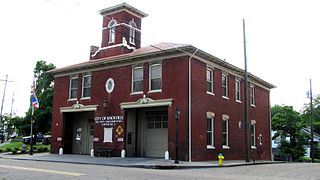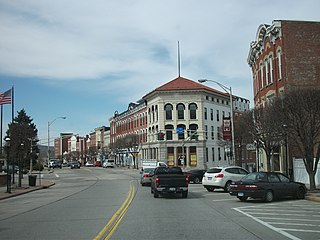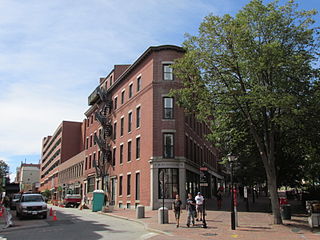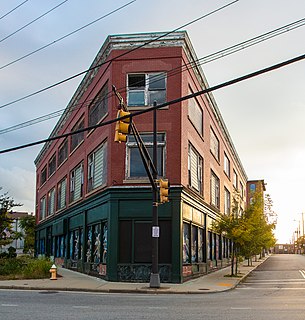Kickapoo Building | |
The Kickapoo Building in 2016 | |
| Location | 726 W. Main St., Peoria, Illinois |
|---|---|
| Coordinates | 40°41′48″N89°35′40″W / 40.69667°N 89.59444°W Coordinates: 40°41′48″N89°35′40″W / 40.69667°N 89.59444°W |
| Built | 1911 |
| Built by | John Hartwig |
| Architect | Albert Keifer |
| Architectural style | Classical Revival |
| NRHP reference # | 13001005 [1] |
| Added to NRHP | December 31, 2013 |
The Kickapoo Building is a historic commercial building located at 726 West Main Street in Peoria, Illinois. Built in 1911, the building was originally used as a tied house for the Anheuser-Busch Brewery, which sought to expand its presence in Peoria's large brewing industry. The two-story building has a flatiron shape, a design which took advantage of its triangular lot. Architect Albert Keifer gave the building a Classical Revival design with German Renaissance Revival features. [2]

Peoria is the county seat of Peoria County, Illinois, and the largest city on the Illinois River. Established in 1691 by the French explorer Henri de Tonti, Peoria is the oldest European settlement in Illinois, and is named after the Peoria tribe. As of the 2010 census, the city was the seventh-most populated in Illinois, with a population of 115,007. The Peoria Metropolitan Statistical Area had a population of 373,590 in 2011. Until 2018, Peoria was the global and national headquarters for Caterpillar Inc., one of the 30 companies composing the Dow Jones Industrial Average, and listed on the Fortune 100; in the latter year, the company relocated its headquarters to Deerfield, Illinois.

Illinois is a state in the Midwestern and Great Lakes region of the United States. It has the fifth largest gross domestic product (GDP), the sixth largest population, and the 25th largest land area of all U.S. states. Illinois is often noted as a microcosm of the entire United States. With Chicago in northeastern Illinois, small industrial cities and immense agricultural productivity in the north and center of the state, and natural resources such as coal, timber, and petroleum in the south, Illinois has a diverse economic base, and is a major transportation hub. Chicagoland, Chicago's metropolitan area, encompasses over 65% of the state's population. The Port of Chicago connects the state to international ports via two main routes: from the Great Lakes, via the Saint Lawrence Seaway, to the Atlantic Ocean and from the Great Lakes to the Mississippi River, via the Illinois Waterway to the Illinois River. The Mississippi River, the Ohio River, and the Wabash River form parts of the boundaries of Illinois. For decades, Chicago's O'Hare International Airport has been ranked as one of the world's busiest airports. Illinois has long had a reputation as a bellwether both in social and cultural terms and, through the 1980s, in politics.

In the United Kingdom, a tied house is a public house required to buy at least some of its beer from a particular brewery or pub company. That is in contrast to a free house, which is able to choose the beers it stocks freely.
Flatiron buildings were once commonly built in Peoria as a necessity of the city's geography; while downtown Peoria was built on a grid aligned with the Illinois River, its subsequent additions were usually aligned with the cardinal directions, and extensions of streets from the additions into downtown led to the creation of many triangular lots. The Kickapoo Building's lot was created by three of these streets, Main Street and Glendale Avenue from the original downtown and Knoxville from the boundaries of several later additions; while it was not the first building on its triangular lot, it was the first one to take full advantage of the space. Modern commercial development and freeway construction eliminated many of Peoria's diagonal streets downtown, including Knoxville Avenue itself, and took many of its flatiron buildings with it; the Kickapoo Building stands out among the survivors for its decorative commercial storefronts on all three sides. [2]

The Illinois River is a principal tributary of the Mississippi River, approximately 273 miles (439 km) long, in the U.S. state of Illinois. The river drains a large section of central Illinois, with a drainage basin of 28,756.6 square miles (74,479 km2). The drainage basin extends into Wisconsin, Indiana, and a very small area of southwestern Michigan. This river was important among Native Americans and early French traders as the principal water route connecting the Great Lakes with the Mississippi. The French colonial settlements along the rivers formed the heart of the area known as the Illinois Country. After the construction of the Illinois and Michigan Canal and the Hennepin Canal in the 19th century, the role of the river as link between Lake Michigan and the Mississippi was extended into the era of modern industrial shipping. It now forms the basis for the Illinois Waterway.
The building was added to the National Register of Historic Places on December 31, 2013. [1]

The National Register of Historic Places (NRHP) is the United States federal government's official list of districts, sites, buildings, structures, and objects deemed worthy of preservation for their historical significance. A property listed in the National Register, or located within a National Register Historic District, may qualify for tax incentives derived from the total value of expenses incurred preserving the property.























